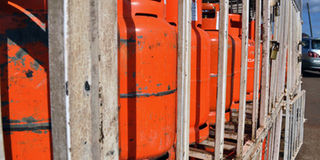What lies ahead for Uganda’s gas

Cylinders of LPG gas used for cooking and hitting. PHOTO/RACHEL MABALA
What you need to know:
For now, the Uganda government plans to use the current gas reservoirs for the generation of large scale electricity supply to add to the current power supply of 504 megawatts.
Collective investments made in oil and gas explorations since 1998 to date are estimated to be about $1.7 billion.
Since the commercial discovery of oil in Uganda, less has been said about the vast potential of natural gas reserves that coexist alongside the 3.5 billion barrels of oil.
Gas is a natural hydrocarbon mixture of methane [good as a fuel component], ethane, butane, propane, nitrogen, hydrogen and carbon dioxide.
In hydrocarbon rich grounds like the Albertine Graben stretch, where oil exploration is taking shape, the presence of natural gas is high and is usually found in the natural rock formations along with underground water and oil.
When natural gas is refined it produces Compressed Natural Gas (CNG), Liquefied Natural Gas (LNG) and Liquefied Petroleum Gas (LPG); all used differently for domestic purposes like cooking, heating and automobile fuel.
For now, the Uganda government plans to use the current gas reservoirs for the generation of large scale electricity supply to add to the current power supply of 504 megawatts.
Mr Honey Malinga, the assistant commissioner-Geophysics, at the Petroleum Exploration and Production Department (PEPD), recently told Prosper that plans were in advanced stages to ensure that the resource is optimally extracted and utilised.
“The amount of gas reserves is not yet ascertained because appraisal of the discoveries is still on-going but we have about 93 billion cubic feet of non–associated gas from the fields of Nzizi, Ngiri, Kasamene, Kigogole, Ngege, Jobi-Rii, Ngassa, Nsoga and Jobi East,” he said.
In an ideal reservoir there are two types of gas resources; associated (dissolved and gas cap) and non-associated gas (sometimes referred to as free gas), however most of Uganda’s discoveries is associated gas - located at the tip or within oil fields.
According to Mr Malinga the available associated gas could amount to about 192 million standard cubic feet - located in fields like Mputa, Waraga, Kingfisher and Nzizi.
Other wells including Kasamene, Kigogole, Nsoga, Wairhindi, Ngara, Lyec, Mpyo, Gunya, Ngiri, Jobi-Rii and Jobi-East have also been found to have some embedments of natural gas.
“The amount of gas reservoirs may increase if the exploration companies make more discoveries. However, we are working on some of the fields to establish the type of gas contained therein,” says Mr Malinga.
It is expected according to Mr Malinga that the same companies -France’s Total SA, China’s CNOOC and UK’s Tullow, yet to get oil production licenses will similarly be involved in the extraction of the gas resource because the licence permits them exclusive rights.
Electricity production
Mr Malinga says the government through the Ministry of Energy and the Electricity Regulatory Authority (ERA) are trying to fast track all plans to commence electricity production.
“The selection of a company to set up the Integrated Power Project which is expected to produce between 50 and 80 megawatts of electricity is in advanced stages, he says.
“The project’ he adds ‘will utilise gas from the Nzizi field in addition to crude from the Mputa oil field.”
Expected Increase in the quantities
Mr Malinga says the current findings are not final, since only a fraction of the entire Albertine stretch has been appraised while more discoveries were in offing, and more so, the open flaring (burning off) practice was banned.
A 2012 report by Ernest and Young titled ‘Natural Gas in Africa’ reported that, “associated gas is currently mainly re-injected or flared but governments are keen to target gas for domestic use,” allegations Mr. Malinga dismissed.
He although acknowledged that, previously the oil companies open flared both oil and gas (because the volumes involved at that time were too small to realise their commerciality), but the practice has since been stopped.
To date, over 20 seismic studies have been undertaken with 89 exploration and appraisal wells drilled, of which 76 have encountered oil and/gas representing a drilling success rate of over 85 percent.
Only 40 percent of the Albertine Graben has been explored and appraised so far which implies that more gas discoveries are yet to found.
Collective investments made in oil and gas explorations since 1998 to date are estimated to be $1.7 billion.
Future competition
Much as government has not expressed any interest to export any of its gas resource, there is likely competition from countries like Kenya, Tanzania, Ethiopia, and Mozambique, all in the East African region, which are currently a hub gas exploration.
Africa & gas
According to the Oil & Gas Journal, proved reserves of natural gas in Africa are estimated at around 14 tcm, as of January 1, 2012. Africa’s gas reserves are about 7.5 per cent of the world’s total. Technically recoverable reserves of natural gas in Africa are substantially higher, estimated at about 74 tcm, almost 10 per cent of the world’s total. Africa’s proved gas reserves are highly concentrated, with four countries — Nigeria, Algeria, Egypt and Libya — accounting for more than 92 per cent of the continent’s total.
Africa’s gas production reached about 203 bcm in 2011, with production led by Algeria, Egypt and Nigeria, collectively accounting for more than 88 per cent of the continent’s total. Gas production in Africa since 2000 has been growing by about 4 per cent per year. African natural gas consumption is estimated to have been about 110 bcm in 2011, with Egypt and Algeria leading consumption totals.
Source: Ernest & Young Report
THE NUMBERS
93 billion: The amount of gas in cubic feet of non–associated gas currently available.
192 million: The amount of associated gas in standard cubic feet located in Mputa, Waraga, Kingfisher and Nzizi.




